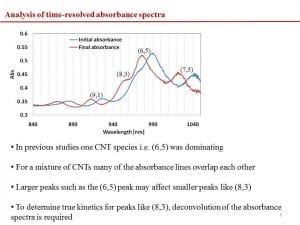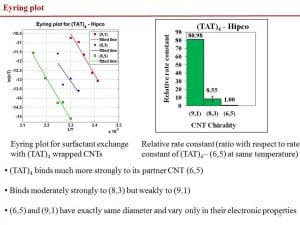The optical absorbance and fluorescence of single-wall carbon nanotubes have peaks that represent band-gap absorbance and photoluminescence (PL). Peak location (and intensity for PL) in the spectrum is very sensitive to the local environment, a solvatochromic effect. We use this effect to study the kinetics of displacing biological molecules from the surface of CNTs.
Roxbury, Daniel, Xiaomin Tu, Ming Zheng, and Anand Jagota. “Recognition ability of DNA for carbon nanotubes correlates with their binding affinity.”Langmuir 27, no. 13 (2011): 8282-8293.
Roxbury, Daniel, Shao-Qing Zhang, Jeetain Mittal, William F. DeGrado, and Anand Jagota. “Structural Stability and Binding Strength of a Designed Peptide-Carbon Nanotube Hybrid.” The Journal of Physical Chemistry C (2013).
Shankar, Akshaya, Jeetain Mittal, and Anand Jagota. “Binding between DNA and carbon nanotubes strongly depends upon sequence and chirality.” Langmuir 30, no. 11 (2014): 3176-3183.
We have also used such spectroscopy to quantify DNA/SWCNT solvation differences using Aqueous Two Phase Separation.
Yang, Yoona, Akshaya Shankar, Thibault Aryaksama, Ming Zheng, and Anand Jagota. “Quantification of DNA/SWCNT Solvation Differences by Aqueous Two-Phase Separation.” Langmuir 34, no. 5 (2018): 1834-1843.
See pictures below:









